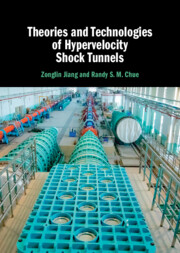Book contents
- Theories and Technologies of Hypervelocity Shock Tunnels
- Theories and Technologies of Hypervelocity Shock Tunnels
- Copyright page
- Contents
- Preface
- 1 Introduction
- 2 Shock-Wave Relations and Aerothermodynamic States
- 3 Heated Light-Gas High-Enthalpy Shock Tunnels
- 4 Free-Piston-Driven High-Enthalpy Shock Tunnels
- 5 Detonation-Driven High-Enthalpy Shock Tunnels
- 6 Theory and Methods for Long-Test-Duration Shock Tunnels
- 7 Methods for Designing High-Enthalpy Flow Nozzles
- 8 Aerothermodynamic Testing and Hypersonic Physics
- Index
- References
1 - Introduction
- Theories and Technologies of Hypervelocity Shock Tunnels
- Theories and Technologies of Hypervelocity Shock Tunnels
- Copyright page
- Contents
- Preface
- 1 Introduction
- 2 Shock-Wave Relations and Aerothermodynamic States
- 3 Heated Light-Gas High-Enthalpy Shock Tunnels
- 4 Free-Piston-Driven High-Enthalpy Shock Tunnels
- 5 Detonation-Driven High-Enthalpy Shock Tunnels
- 6 Theory and Methods for Long-Test-Duration Shock Tunnels
- 7 Methods for Designing High-Enthalpy Flow Nozzles
- 8 Aerothermodynamic Testing and Hypersonic Physics
- Index
- References
Summary
In order to introduce hypersonic ground testing facilities, background information in hypersonics is presented to show to readers what we want to do, where we have been, and where we are going to go. These will provide with a good indication of the research needs that are called as hypersonic vehicle ground testing. It is of fundamental importance that a vehicle design must be carefully evaluated in ground test facilities before flight testing can proceed. Indeed, the development of hypersonic vehicles is related to the capability development of hypersonic ground testing facilities.
- Type
- Chapter
- Information
- Publisher: Cambridge University PressPrint publication year: 2023



